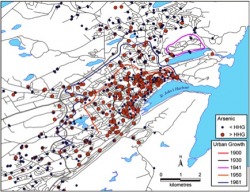Residential soil analysis in St. John’s reveals elevated levels for 10 metals

New paper explores the geochemical landscape of St. John’s and the potential impacts for ecosystem and human health
A recent paper in Atlantic Geology, coauthored by Environmental Science graduate student Robert Foley and Geography professors Trevor Bell and David Liverman, explores the potential impact for ecosystem and human health of metal levels in St. John’s soil. “Our study took advantage of a large database of metal concentrations in residential soil samples from across the city that were collected as part of a soil lead project in 200X” observed Trevor Bell. “The laboratory had analyzed the samples for a wide range of metals other than lead and so there was a lot of data - over 10,000 values - waiting to be analysed when Robert knocked on my office door looking for a graduate research project.”
The team looked specifically at levels of arsenic, barium, cadmium, cobalt, chromium, copper, nickel, lead, vanadium and zinc. “We chose these metals because Canada has identified soil quality guidelines for them to protect both environmental and human health” said Robert Foley. “When these guideline levels are exceeded, it may indicate a potential hazard for residents and animals exposed to the soil or plants growing in the soil.”
Commenting on the uniqueness of the study, Dr. Liverman observed that “urban geochemical studies in general have tended to concentrate on large cities with major transportation and/or industrial activities, such as New Orleans or Chicago, whereas St. John’s is a relatively small port city where, apart from small-scale commercial and industrial enterprises that served the local community, there is no history of major industrialization.”
Their study results showed that:
- all ten metals had elevated levels in urban soils compared to rural sites,
- five of the ten metals – arsenic, barium, copper, lead and zinc – had concentrations above environmental health guidelines in more than one-fifth of the samples analyzed, and
- three metals – arsenic, lead and vanadium – exceeded human health guidelines in one-third to one-half of samples.
Using a contamination index, soils in the downtown area and on residential properties predating the 1950s were classified as highly contaminated.
Using statistical techniques, the research team was able to identify clusters of metals in soil samples and together with their spatial patterns to suggest that weathered paint, vehicular emissions, and coal burning were important sources for the main metal contaminants in the sampled soils.
Of the three metals that significantly exceeded human health guidelines, lead and arsenic pose the greatest potential health risk. Another St. John’s study co-lead by Dr. Bell recently reported that lead levels in children’s blood (the most vulnerable population for lead exposure) were relatively low with none above national reference levels. Despite these reassuring results, the project leaders encouraged St. John’s residents to remain vigilant about the potential exposure of children to lead in older homes from dust, paint, renovations and tracking of soil inside. Next steps in the assessment of arsenic as a potential health hazard will be to confirm the source and determine the form of arsenic in local soils.
The authors conclude their paper by suggesting that similar soil geochemical hazards may exist in other Canadian cities that share a similar urban history of painted clapboard, coal burning and vehicular use.
Its full publication details are: Foley, R., Bell, T., and Liverman, D.G.E. Urban Geochemical Hazard Mapping: the Case Study of St. John’s, Newfoundland. Atlantic Geology, 47: 138–157.
The paper can be accessed online at: journals.hil.unb.ca/index.php/ag/article/view/atlgeol.2011.007